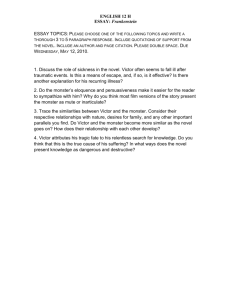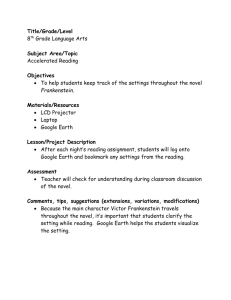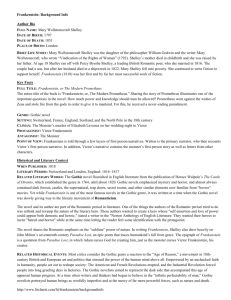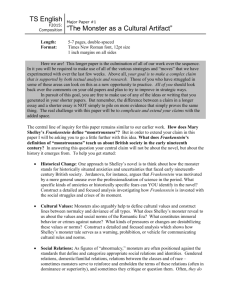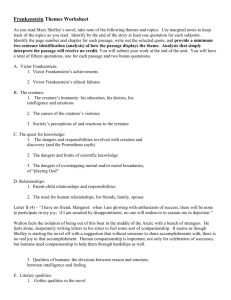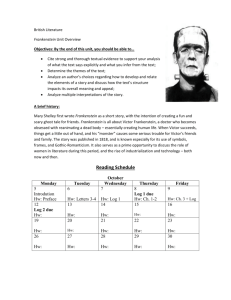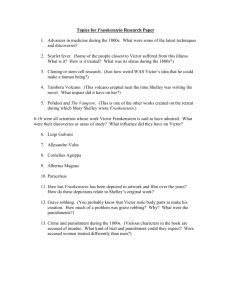5N_September lessons.doc
advertisement
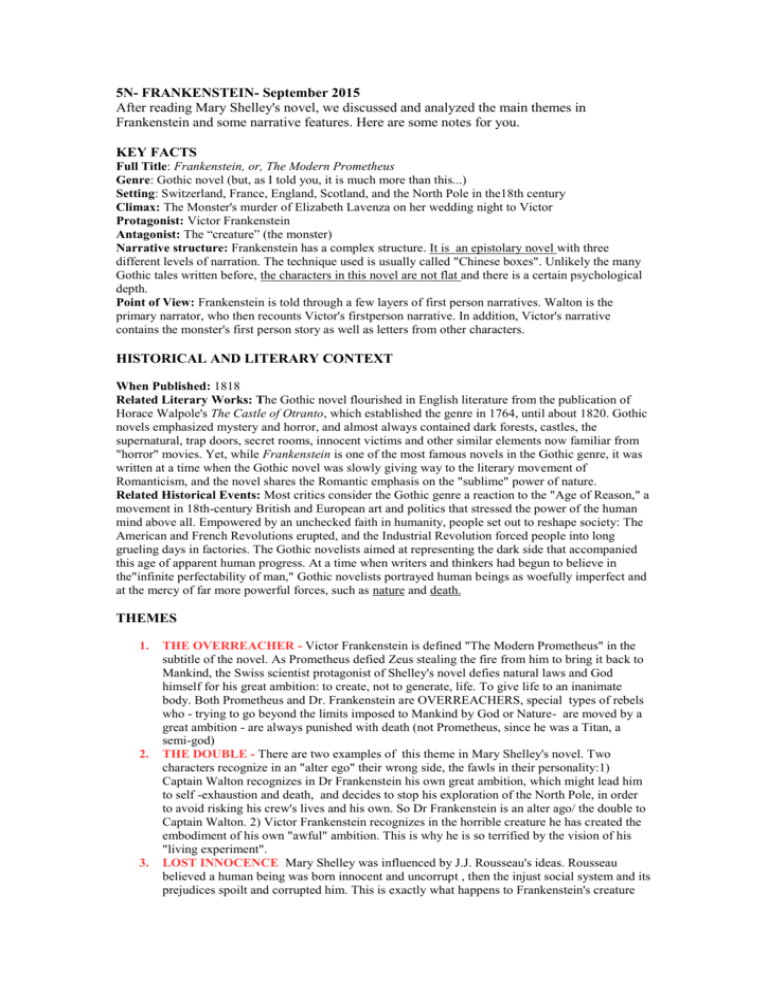
5N- FRANKENSTEIN- September 2015 After reading Mary Shelley's novel, we discussed and analyzed the main themes in Frankenstein and some narrative features. Here are some notes for you. KEY FACTS Full Title: Frankenstein, or, The Modern Prometheus Genre: Gothic novel (but, as I told you, it is much more than this...) Setting: Switzerland, France, England, Scotland, and the North Pole in the18th century Climax: The Monster's murder of Elizabeth Lavenza on her wedding night to Victor Protagonist: Victor Frankenstein Antagonist: The “creature” (the monster) Narrative structure: Frankenstein has a complex structure. It is an epistolary novel with three different levels of narration. The technique used is usually called "Chinese boxes". Unlikely the many Gothic tales written before, the characters in this novel are not flat and there is a certain psychological depth. Point of View: Frankenstein is told through a few layers of first person narratives. Walton is the primary narrator, who then recounts Victor's firstperson narrative. In addition, Victor's narrative contains the monster's first person story as well as letters from other characters. HISTORICAL AND LITERARY CONTEXT When Published: 1818 Related Literary Works: The Gothic novel flourished in English literature from the publication of Horace Walpole's The Castle of Otranto, which established the genre in 1764, until about 1820. Gothic novels emphasized mystery and horror, and almost always contained dark forests, castles, the supernatural, trap doors, secret rooms, innocent victims and other similar elements now familiar from "horror" movies. Yet, while Frankenstein is one of the most famous novels in the Gothic genre, it was written at a time when the Gothic novel was slowly giving way to the literary movement of Romanticism, and the novel shares the Romantic emphasis on the "sublime" power of nature. Related Historical Events: Most critics consider the Gothic genre a reaction to the "Age of Reason," a movement in 18th-century British and European art and politics that stressed the power of the human mind above all. Empowered by an unchecked faith in humanity, people set out to reshape society: The American and French Revolutions erupted, and the Industrial Revolution forced people into long grueling days in factories. The Gothic novelists aimed at representing the dark side that accompanied this age of apparent human progress. At a time when writers and thinkers had begun to believe in the"infinite perfectability of man," Gothic novelists portrayed human beings as woefully imperfect and at the mercy of far more powerful forces, such as nature and death. THEMES 1. 2. 3. THE OVERREACHER - Victor Frankenstein is defined "The Modern Prometheus" in the subtitle of the novel. As Prometheus defied Zeus stealing the fire from him to bring it back to Mankind, the Swiss scientist protagonist of Shelley's novel defies natural laws and God himself for his great ambition: to create, not to generate, life. To give life to an inanimate body. Both Prometheus and Dr. Frankenstein are OVERREACHERS, special types of rebels who - trying to go beyond the limits imposed to Mankind by God or Nature- are moved by a great ambition - are always punished with death (not Prometheus, since he was a Titan, a semi-god) THE DOUBLE - There are two examples of this theme in Mary Shelley's novel. Two characters recognize in an "alter ego" their wrong side, the fawls in their personality:1) Captain Walton recognizes in Dr Frankenstein his own great ambition, which might lead him to self -exhaustion and death, and decides to stop his exploration of the North Pole, in order to avoid risking his crew's lives and his own. So Dr Frankenstein is an alter ago/ the double to Captain Walton. 2) Victor Frankenstein recognizes in the horrible creature he has created the embodiment of his own "awful" ambition. This is why he is so terrified by the vision of his "living experiment". LOST INNOCENCE Mary Shelley was influenced by J.J. Rousseau's ideas. Rousseau believed a human being was born innocent and uncorrupt , then the injust social system and its prejudices spoilt and corrupted him. This is exactly what happens to Frankenstein's creature 4. 5. 6. 7. who was naturally good when he came to life but was then turned into an evil murderer by the prejudices of all the human beings he met, starting with his creator. He was rejected because of his ugly appearance. SCIENCE AND MORALS Frankenstein is considered the forerunner of the science fiction genre. The novelist fascinated by physiology, chemistry and physics, reflects on the relationship between science and morals - something we call bioethics nowadays - wondering what the destiny of someone who overcomes the border might be. FAMILY, SOCIETY, ISOLATION. In its preface, Frankenstein claims to be a novel that gives a flattering depiction of "domestic affection." That seems a strange claim in a novel full of murder, tragedy, and despair. But, in fact, all that tragedy, murder, and despair occur because of a lack of connection to either family or society. To put it in another way, the true evil in Frankenstein is not Victor or the monster, but isolation. When Victor becomes lost in his studies he removes himself from human society, and therefore loses sight of his responsibilities and the consequences of his actions. The monster turns vengeful not because it's evil, but because his isolation fills it with overwhelming hate and anger. And what is the monster's vengeance? To make Victor as isolated as it. Add it all up, and it becomes clear that Frankenstein sees isolation from family and society as the worst imaginable fate, and the cause of hatred, violence, and revenge. REVENGE The “creature” begins his life with a warm, open heart. But after he is abandoned and mistreated first by Victor and then by the De Lacey family, the monster turns to revenge. The monster's actions are understandable: he has been hurt by the unfair rejection of a humanity that cannot see past its own prejudices, and in turn wants to hurt those who hurt it. Revenge does not just consume the monster, however. It also consumes Victor, the victim of the monster's revenge. After the monster murders Victor's relatives, Victor vows a "great and signal revenge on [the monster's] cursed head." In a sense then, the very human desire for revenge transforms both Victor and the monster into true monsters that have no feelings or desires beyond destroying their foe. PREJUDICE Frankenstein explores one of mankind's most persistent and destructive flaws: prejudice. Nearly every human character in the novel assumes that the monster must be dangerous based on its outward appearance, when in truth the monster is (originally) warm and open-hearted. Again and again the monster finds himself assaulted and rejected by entire villages and families despite his attempts to convey his benevolent intentions. The violence and prejudice he encounters convinces him of the "barbarity of man." That the only character who accepts the monster is a blind man, De Lacey, suggests that the monster is right: mankind is barbaric, and blinded by its own prejudice. NARRATIVE FEATURES Frankenstein has a complex structure. It is an epistolary novel with three different levels of narration, three narrators and different points of view. The technique used is usually called "Chinese boxes". Unlikely the many Gothic tales written before, the characters in this novel are not flat and there is a certain psychological depth.

